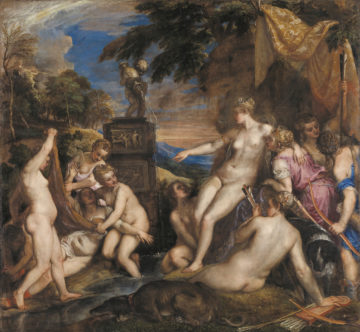Emmelyn Butterfield-Rosen at Artforum:
 FEW FACES TO MEET the public spotlight in recent years have more to tell about the mental mechanisms of male shame, impunity, and self-absolution than that of the furry brown-and-white-spotted Spanish pointer staring out of Titian’s Diana and Callisto, 1556–59. This dog has been a bad dog, as he seems to know. (I say “he” since, according to the visual logic of gender organizing the suite of pictures of which Diana and Callisto forms one-sixth, Titian’s “big dog” simply can’t be a bitch.)1 Sometime previously, on a hunting trip that took an unexpected twist, this Spanish pointer turned against and devoured his master, Actaeon, a human hunter whom Diana, goddess of chastity, transformed into a stag after he came upon her bathing naked. Diana and Callisto asks its viewer to contemplate the aftermath of that attack; his master having passed through his digestive system, Actaeon’s dog, portrayed in another of the series’ pictures, reappears as a tagalong—or the captive?—of Diana’s band of proto-feminist separatists. Titian gives us the gaze of this pointer at the moment Diana is exiling Callisto, a favorite nymph who broke—unwillingly—her vow of virginity.
FEW FACES TO MEET the public spotlight in recent years have more to tell about the mental mechanisms of male shame, impunity, and self-absolution than that of the furry brown-and-white-spotted Spanish pointer staring out of Titian’s Diana and Callisto, 1556–59. This dog has been a bad dog, as he seems to know. (I say “he” since, according to the visual logic of gender organizing the suite of pictures of which Diana and Callisto forms one-sixth, Titian’s “big dog” simply can’t be a bitch.)1 Sometime previously, on a hunting trip that took an unexpected twist, this Spanish pointer turned against and devoured his master, Actaeon, a human hunter whom Diana, goddess of chastity, transformed into a stag after he came upon her bathing naked. Diana and Callisto asks its viewer to contemplate the aftermath of that attack; his master having passed through his digestive system, Actaeon’s dog, portrayed in another of the series’ pictures, reappears as a tagalong—or the captive?—of Diana’s band of proto-feminist separatists. Titian gives us the gaze of this pointer at the moment Diana is exiling Callisto, a favorite nymph who broke—unwillingly—her vow of virginity.
more here.
